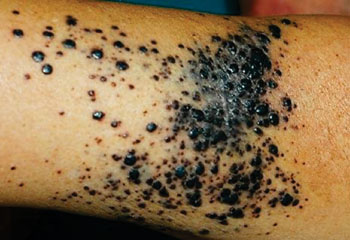Blood Test Monitors DNA Fragments for Melanoma Metastases
|
By LabMedica International staff writers Posted on 25 Jan 2016 |

Image: Clinical features of local recurrences that are defined as the reappearance of melanoma in or contiguous with an excision scar or graft and bearing an in situ component (Photo courtesy of Dr. Paola Savoia).
A blood test which monitors blood levels of DNA fragments from dead cancer cells does a superior job than the current standard test at tracking the severity and potential spread of metastatic melanoma.
The standard test, in widespread use for decades to inform treatment decisions, measures blood levels of the enzyme lactate dehydrogenase (LDH). Levels of the enzyme tend to spike during aggressive tumor growth, but are also known to rise as part of other diseases and biological functions.
Scientists at the New York University School of Medicine (NY, USA) and their colleagues looks at levels of circulating tumor DNA, or ctDNA, released into the blood when tumor cells die and break apart to spill their contents. They studied 31 patients with inoperable metastatic melanoma, which took three years to complete. All had one of the two most common genetic mutations linked to the frequently fatal skin cancer, B-Raf Proto-Oncogene, Serine/Threonine Kinase (BRAF) or Neuroblastoma RAS Viral (V-Ras) Oncogene Homolog (NRAS). All had ctDNA and LDH blood tests performed after therapy, and most before treatment.. Normal blood levels of ctDNA were statistically determined by averaging results from 30 people who did not have melanoma.
The ctDNA levels were determined using droplet digital PCR (ddPCR) assays. Among patients with samples available prior to treatment initiation ctDNA and LDH levels were elevated in 12/15 (80%) and 6/20 (30%) patients respectively. In patients with Response Evaluation Criteria In Solid Tumors (RECIST) scores greater than 5 cm prior to treatment initiation, ctDNA levels were elevated in 5/7 (71%) patients compared to LDH which was elevated in 1/13 (8%) patients. In addition, ctDNA levels were elevated in 13/16 (81%) instances of non-RECIST disease progression, including 10/12 (83%) instances of new brain metastases. In comparison LDH was elevated 8/16 (50%) instances of non-RECIST disease progression, including 6/12 (50%) instances of new brain metastases.
David Polsky, MD, PhD, the senior author of the study, said, “Our study results show that circulating tumor DNA is a superior blood test for evaluating and tracking progression of metastatic melanoma. A reliable blood test for tracking potential disease progression is preferred because blood tests offer feedback on what is happening throughout the body, while scans may not always visualize all parts of the body.” The study was published in the January, 2016 edition of the journal Molecular Oncology.
Related Links:
New York University School of Medicine
The standard test, in widespread use for decades to inform treatment decisions, measures blood levels of the enzyme lactate dehydrogenase (LDH). Levels of the enzyme tend to spike during aggressive tumor growth, but are also known to rise as part of other diseases and biological functions.
Scientists at the New York University School of Medicine (NY, USA) and their colleagues looks at levels of circulating tumor DNA, or ctDNA, released into the blood when tumor cells die and break apart to spill their contents. They studied 31 patients with inoperable metastatic melanoma, which took three years to complete. All had one of the two most common genetic mutations linked to the frequently fatal skin cancer, B-Raf Proto-Oncogene, Serine/Threonine Kinase (BRAF) or Neuroblastoma RAS Viral (V-Ras) Oncogene Homolog (NRAS). All had ctDNA and LDH blood tests performed after therapy, and most before treatment.. Normal blood levels of ctDNA were statistically determined by averaging results from 30 people who did not have melanoma.
The ctDNA levels were determined using droplet digital PCR (ddPCR) assays. Among patients with samples available prior to treatment initiation ctDNA and LDH levels were elevated in 12/15 (80%) and 6/20 (30%) patients respectively. In patients with Response Evaluation Criteria In Solid Tumors (RECIST) scores greater than 5 cm prior to treatment initiation, ctDNA levels were elevated in 5/7 (71%) patients compared to LDH which was elevated in 1/13 (8%) patients. In addition, ctDNA levels were elevated in 13/16 (81%) instances of non-RECIST disease progression, including 10/12 (83%) instances of new brain metastases. In comparison LDH was elevated 8/16 (50%) instances of non-RECIST disease progression, including 6/12 (50%) instances of new brain metastases.
David Polsky, MD, PhD, the senior author of the study, said, “Our study results show that circulating tumor DNA is a superior blood test for evaluating and tracking progression of metastatic melanoma. A reliable blood test for tracking potential disease progression is preferred because blood tests offer feedback on what is happening throughout the body, while scans may not always visualize all parts of the body.” The study was published in the January, 2016 edition of the journal Molecular Oncology.
Related Links:
New York University School of Medicine
Latest Clinical Chem. News
- POC Saliva Testing Device Predicts Heart Failure in 15 Minutes

- Screening Tool Detects Multiple Health Conditions from Single Blood Drop
- Integrated Chemistry and Immunoassay Analyzer with Extensive Assay Menu Offers Flexibility, Scalability and Data Commutability
- Rapid Drug Test to Improve Treatment for Patients Presenting to Hospital
- AI Model Detects Cancer at Lightning Speed through Sugar Analyses
- First-Ever Blood-Powered Chip Offers Real-Time Health Monitoring
- New ADLM Guidance Provides Expert Recommendations on Clinical Testing For Respiratory Viral Infections
- 3D Printed Point-Of-Care Mass Spectrometer Outperforms State-Of-The-Art Models
- POC Biomedical Test Spins Water Droplet Using Sound Waves for Cancer Detection
- Highly Reliable Cell-Based Assay Enables Accurate Diagnosis of Endocrine Diseases
- New Blood Testing Method Detects Potent Opioids in Under Three Minutes
- Wireless Hepatitis B Test Kit Completes Screening and Data Collection in One Step
- Pain-Free, Low-Cost, Sensitive, Radiation-Free Device Detects Breast Cancer in Urine
- Spit Test Detects Breast Cancer in Five Seconds
- Electrochemical Sensors with Next-Generation Coating Advances Precision Diagnostics at POC
- First-Of-Its-Kind Handheld Device Accurately Detects Fentanyl in Urine within Seconds
Channels
Clinical Chemistry
view channel.jpg)
POC Saliva Testing Device Predicts Heart Failure in 15 Minutes
Heart failure is a serious condition where the heart muscle is unable to pump sufficient oxygen-rich blood throughout the body. It ranks as a major cause of death globally and is particularly fatal for... Read more
Screening Tool Detects Multiple Health Conditions from Single Blood Drop
Infrared spectroscopy, a method using infrared light to study the molecular composition of substances, has been a foundational tool in chemistry for decades, functioning similarly to a molecular fingerprinting... Read more
Integrated Chemistry and Immunoassay Analyzer with Extensive Assay Menu Offers Flexibility, Scalability and Data Commutability
As global healthcare systems increasingly shift towards networked laboratory operational models to enhance efficiency and patient access, there is a greater need for innovative solutions tailored to the... Read moreMolecular Diagnostics
view channel
Respiratory Panel to Help Clinicians Make Precise Treatment Decisions in Outpatient Settings
Respiratory tract infections are the primary reason for visits to emergency departments and subsequent hospitalizations. In the U.S., it is estimated that there are up to 41 million cases of influenza... Read more
Integrating Cardiovascular Risk Biomarkers Aids in Detection of ‘Inflammaging’
Cardiovascular diseases (CVD) continue to be the leading cause of death globally, responsible for nearly one-third of all fatalities worldwide. Traditionally, risk assessment for CVD has focused on well-established... Read more
Genetic Signature in Newborns Predicts Neonatal Sepsis Before Symptoms Appear
Neonatal sepsis, which occurs due to the body’s abnormal response to severe infection within the first 28 days of life, results in approximately 200,000 deaths globally each year. This condition affects around 1.... Read more.jpeg)
Integrating Multiple Protein Markers Predicts Health Outcomes in Chronic Kidney Disease Patients
Previous attempts to discover novel kidney biomarkers as risk factors for chronic kidney disease (CKD) progression have generally focused on evaluating proteins individually, which limits their prognostic... Read moreHematology
view channel
Next Gen CBC and Sepsis Diagnostic System Targets Faster, Earlier, Easier Results
Every hour is critical in protecting patients from infections, yet there are currently limited tools to assist in early diagnosis before patients reach a hospital. The complete blood count (CBC) is a common... Read more
Newly Discovered Blood Group System to Help Identify and Treat Rare Patients
The AnWj blood group antigen, a surface marker discovered in 1972, has remained a mystery regarding its genetic origin—until now. The most common cause of being AnWj-negative is linked to hematological... Read more
Blood Platelet Score Detects Previously Unmeasured Risk of Heart Attack and Stroke
Platelets, which are cell fragments circulating in the blood, play a critical role in clot formation to stop bleeding. However, in some individuals, platelets can become "hyperreactive," leading to excessive... Read moreImmunology
view channel
Computational Tool Predicts Immunotherapy Outcomes for Metastatic Breast Cancer Patients
Immunotherapy aims to enhance the body’s immune response to target cancer cells, but not all patients experience a positive reaction to such treatments. Identifying which patients will benefit from immunotherapy... Read more
Biomarker Could Predict Immunotherapy Response in Liver Cancer
Until recently, patients diagnosed with hepatocellular carcinoma had limited treatment options, with existing therapies extending life by only a few months. Immunotherapy has emerged as a new alternative... Read more
Epigenetic Test Could Determine Efficacy of New Immunotherapy Treatments Against Multiple Myeloma
Multiple myeloma is a blood cancer that primarily affects individuals over the age of sixty, and its occurrence rises as the population ages. In this disease, the bone marrow—the spongy tissue inside bones... Read moreMicrobiology
view channel
High-Accuracy Bedside Test to Diagnose Periprosthetic Joint Infection in Five Minutes
Periprosthetic joint infection (PJI) represents a significant global issue that is worsening as the number of joint replacements increases due to aging populations. In the United States alone, the anticipated... Read more_1.jpg)
Innovative Diagnostic Approach for Bacterial Infections to Enable Faster and Effective Treatment
For patients with bacterial infections, timely treatment with the appropriate antibiotics significantly improves their chances of recovery. Current methods for identifying which antibiotics will be effective... Read more
Non-Invasive Stool Test to Diagnose Endometriosis and Help Reduce Disease Progression
Endometriosis, a painful condition impacting nearly 200 million women globally, occurs when tissue similar to the lining of the uterus grows outside its usual location, such as on the intestines or the... Read more
Automated Positive Blood Culture Sample Preparation Platform Designed to Fight Against Sepsis and AMR
Delayed administration of antibiotics to patients with bloodstream infections significantly increases the risk of morbidity and mortality. For optimal therapeutic outcomes, it is crucial to rapidly identify... Read moreTechnology
view channel
New Noninvasive Methods Detect Lead Exposure Faster, Easier and More Accurately at POC
Exposure to lead can negatively affect health in multiple ways, leading to damage in the brain and central nervous system, delays in development and growth, learning and behavioral issues, problems with... Read more
Noninvasive Test Detects Malaria Without Blood Sample
Malaria remains a significant global health issue, with approximately 250 million cases and over 600,000 deaths reported annually. Nearly half of the world's population is at risk for malaria infection,... Read moreIndustry
view channel
Beckman Coulter Partners with BioPorto for Global Distribution of Acute Kidney Injury NGAL Tests
Acute kidney injury (AKI) is a sudden episode of kidney failure or damage that can occur within a few hours or days. This condition leads to the accumulation of waste products in the blood and disrupts... Read more_1.jpg)
CACLP 2025 New Date and Venue Announced
The 22nd China International In Vitro Diagnostic Expo, organized by the China Association of Clinical Laboratory Practice Expo (CACLP, Shanghai, China), is set to take place from March 21 to 24, 2025,... Read more
Roche to Develop New Diagnostic Technologies for Traumatic Brain Injuries
Traumatic brain injuries (TBI) represent a significant global health issue, affecting approximately 69 million people each year. TBI occurs when an external force disrupts normal brain function, with severity... Read more















